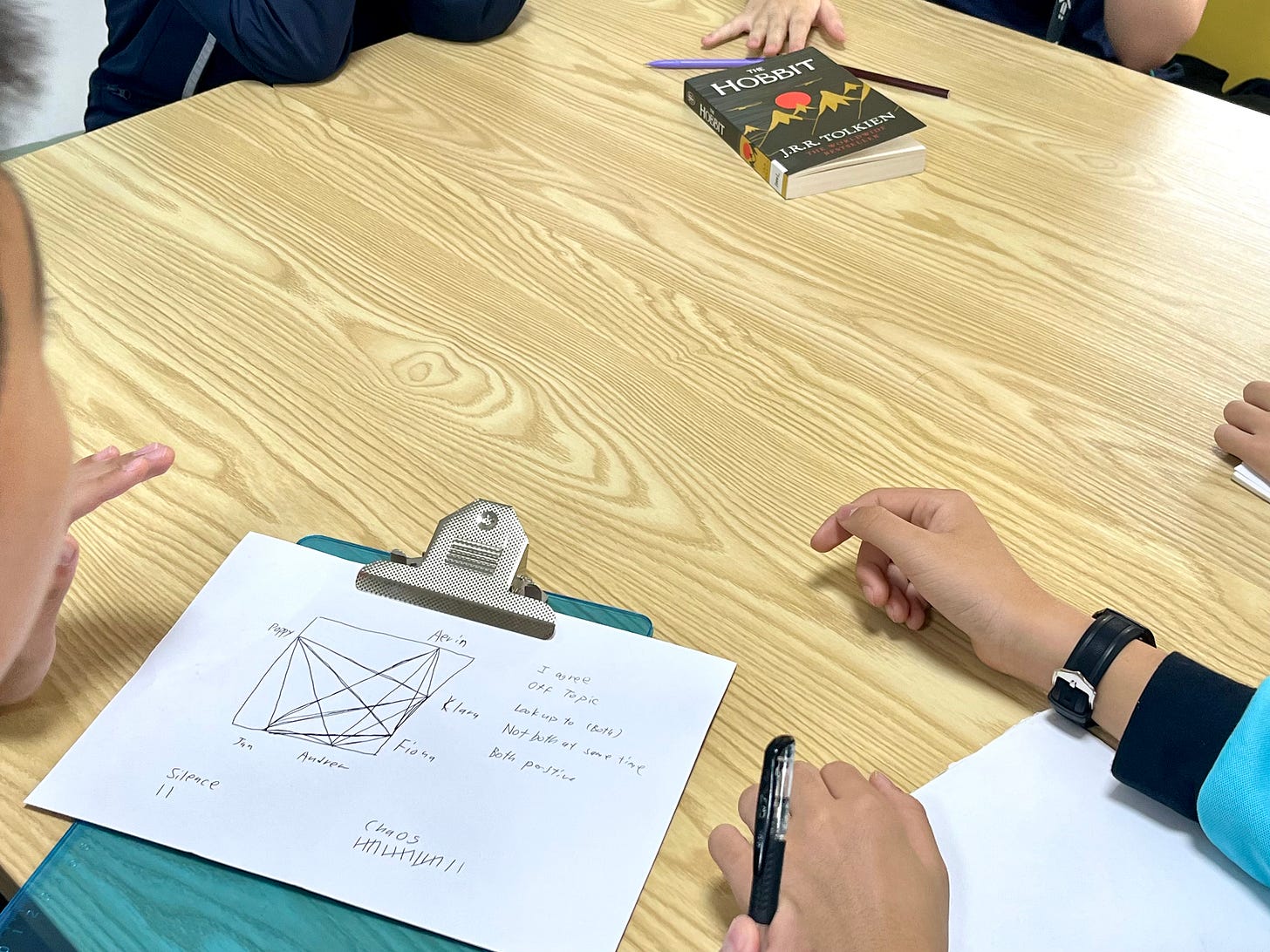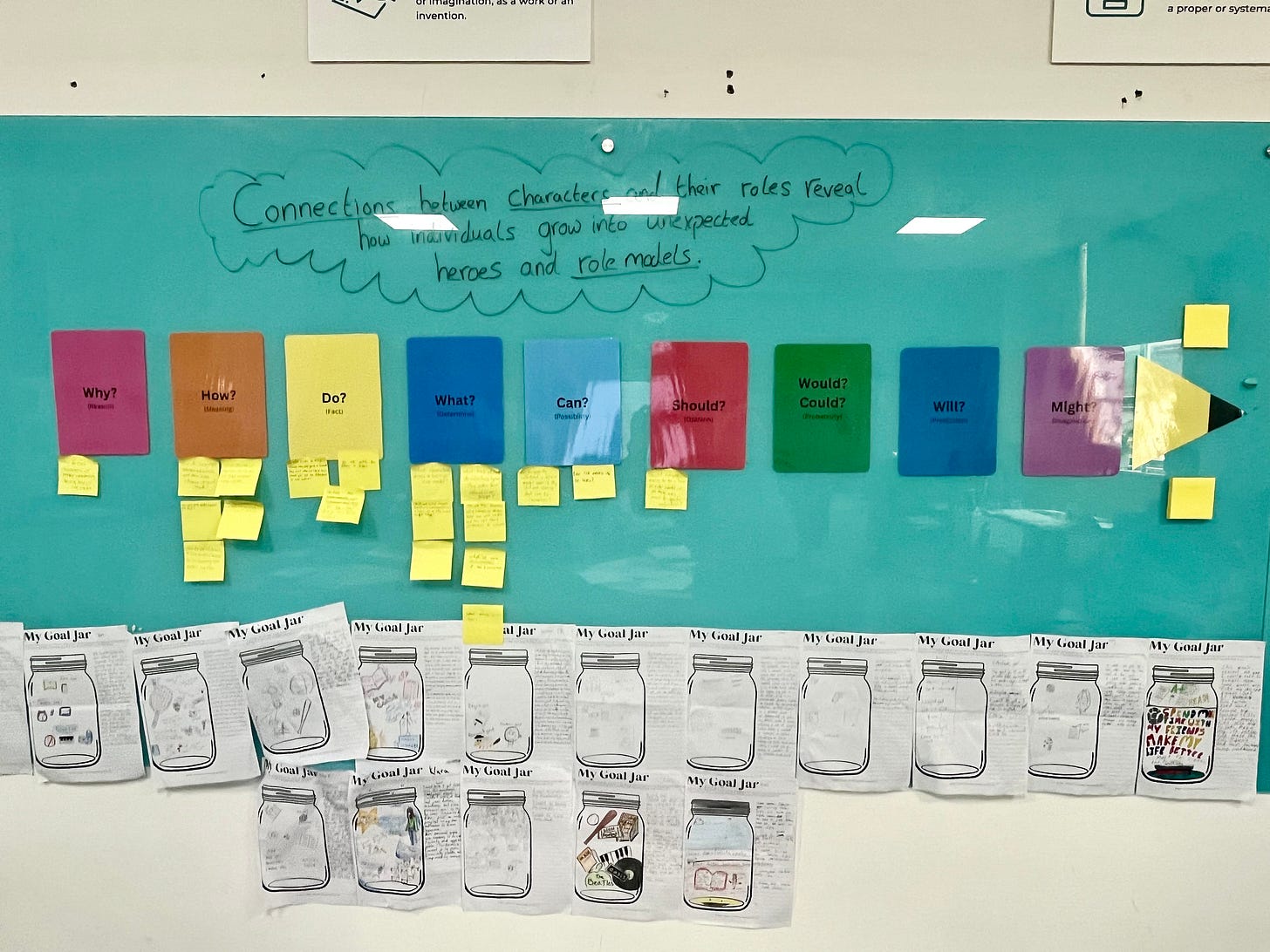A Spiderweb of Questioning: Cultivating Deeper Inquiry in the Classroom
Over the past few years, I have been incorporating spiderweb discussions into my weekly learning experiences, and they have completely transformed the way my students engage with material. Initially, I introduced this method to enhance collaboration and encourage more student-driven dialogue. Since then, spiderweb discussions have become a powerful routine that not only fosters deep critical thinking but also builds a community of inquiry in the classroom. The concept of spiderweb discussions, created by Alexis Wiggins, is inspired by a web’s structure, where connections are made between various points, but no single point is more central than any other. In this format, students guide the conversation while I, the teacher, step back to observe their thought processes and interactions.
So, what exactly are spiderweb discussions? Unlike traditional teacher-led discussions, in spiderweb discussions, students take full control. They sit together, discuss a topic, and their conversation is mapped out in real time, often by a the teacher or, sometimes, in my classroom, by students. The web is formed on paper—or on the Equity Maps app (if you prefer a digital approach). The map is a visual representation of how ideas are connected, demonstrating who is speaking, what they are contributing, and how others are responding. As the discussion unfolds, a clear pattern emerges, allowing the class to track the flow of dialogue and, more importantly, recognize gaps or opportunities for deeper exploration.
This method works beautifully for a variety of reasons. First and foremost, it creates accountability among students. They realize they need to come prepared, not just to speak, but to listen actively and respond thoughtfully. The process also removes me from the center of the conversation, turning the focus onto student interaction. They become leaders of their own learning, which is incredibly empowering. While students develop their skills in verbal expression and argumentation, they also engage in metacognition—they think about their thinking. This reflective component is a significant aspect of why spiderweb discussions have become such a cornerstone of my classroom practice.
Cultivating Critical Thinking and Engagement
My students absolutely love these discussions. The format provides them with a sense of ownership and responsibility for their learning, which in turn boosts engagement. It’s not just about who has the best answers or the most knowledge; it’s about how they collectively build understanding. When students know that their peers are counting on them to contribute to the discussion, they come prepared with insightful questions and are eager to share their thoughts. This has led to an increase in not only their participation but also the depth of their analysis.
Spiderweb discussions naturally enhance students' critical thinking skills. Because they are expected to respond to one another’s comments, they must listen carefully, analyze different perspectives, and think quickly about how to contribute meaningfully to the conversation. This dynamic back-and-forth mirrors real-world problem-solving, where individuals must synthesize information and adapt their responses based on evolving discussions.
Over time, I’ve noticed that students start to develop a more sophisticated approach to questioning. Instead of relying solely on surface-level questions (e.g., “What happened in Chapter 5?”), they begin to explore deeper conceptual and debatable questions (e.g., “How does Bilbo’s decision to take the ring signify his personal growth, and how does it challenge traditional notions of heroism?”). This shift is one of the most rewarding outcomes of spiderweb discussions, as it demonstrates students’ growing ability to think critically and inquire meaningfully.
To read more about Spider web discussions, I recommend you take read Alexis Wiggins’ book. It’s a fantastic read and the routine is simple to implement. Additionally, you can listen to an interview I did with Alexis for my podcast.
Introducing the 'Question Pencil' Routine
Today, I decided to introduce a new element to our spiderweb discussions—the “Question Pencil” routine from Trevor Mackenzie’s Inquiry Mindset: Questions Edition. The Question Pencil routine is designed to support students in honing their questioning techniques, allowing them to refine their questions much like sharpening a pencil. It encourages students to move from broad, unfocused questions to more precise, targeted ones, helping to drive the inquiry process in a structured way.
Actually, when I introduced the Question Pencil routine, I had students start by looking at the key topics of our current unit and reflecting on The Hobbit. I asked them to write down questions they had about the book—questions that related to character growth, themes of heroism, and the connections between characters and their roles. Once they had written their questions, they placed them on a large “question pencil” displayed at the back of the classroom. This visual representation of the routine was a simple yet effective way to remind students of the process of refining their questions.
Once all the questions were up, we took one at random to use as the topic for our spiderweb discussion. This added a fun, slightly unpredictable element to the activity, and it ensured that we tackled a question that truly resonated with the group. For example, the question we ended up selecting today was, “How does Bilbo’s reluctance at the start of the journey contribute to his eventual transformation into an unexpected hero?” This question allowed us to delve deep into the thematic elements of the novel and tied perfectly into our larger inquiry about the nature of heroism and character growth.
Real-World Connections and Unexpected Heroes
In addition to the literary analysis, I also like to tie in relevant real-world examples to make the theme of unexpected heroes even more tangible for my students. We discussed how ordinary people—much like Bilbo Baggins—can find themselves in situations that require courage and leadership. We explored stories of individuals who have stepped up in times of crisis, whether in their communities or on a larger global scale. These real-world connections help students understand that heroism isn’t limited to fiction and that they, too, can be the heroes of their own stories.
We considered individuals like Malala Yousafzai, who, despite her young age and the dangers she faced, became a global symbol for girls’ education and courage. My students were particularly struck by how, like Bilbo, Malala didn’t set out to become a hero. Instead, circumstances pushed her into the role, and she rose to the challenge. These discussions brought the themes of The Hobbit to life in a meaningful and contemporary context.
To further enrich the learning experience and deepen discussion, I introduced a powerful provocation in the form of a short drama advertisement from the Thai phone company 'True Move.' This emotionally charged advert, which tells a story of unexpected kindness and generosity, was an ideal way to stimulate deeper thinking about our unit on growth and unexpected heroes. I played the advert for my students, and afterward, they engaged in a turn and talk activity with their peers, sharing immediate reactions and insights. The aim was to use the advert as a springboard for inquiry and reflection, leading students to formulate meaningful questions.
After the turn and talk, students quickly wrote down questions inspired by the provocation. Some of the questions they generated included:
Do role models do things because they are good or because they want attention?
Do role models always have to be heroes?
What defines a hero?
Can role models also be heroes?
Can someone be considered a hero or role model even if they did not choose that role for themselves?
Why do some characters or people unexpectedly become heroes or role models?
We then voted as a class on which question we would research further, ultimately selecting: Can role models also be heroes? This question would then become the focus of our spiderweb discussion, allowing students to explore the advert's themes in connection with the larger ideas in our unit. It was a rich discussion, with students linking their insights from the provocation to the characters and themes in The Hobbit and real-world examples of heroism.
Using a real-world provocation like this not only energized the classroom but also gave students an opportunity to reflect on heroism from a fresh perspective, making their inquiry all the more meaningful.
Structuring the Discussion: Spider Mappers and the Ladder of Feedback
To make today’s discussion even more interactive, I assigned two students to act as “spider mappers.” Each group was responsible for leading their own spiderweb discussion, mapping out the conversation on a piece of A4 paper. As their peers discussed, the mappers visualized the conversation by drawing lines between speakers and noting the flow of ideas, questions, and responses. This real-time mapping allowed students to track their contributions and observe the overall coherence of the discussion.
Once the two groups completed their discussions, we used another routine to facilitate peer feedback—the “Ladder of Feedback.” This routine is a fantastic tool for helping students offer constructive criticism in a structured, supportive way. The Ladder of Feedback has four steps:
1. Clarify – Ask clarifying questions to ensure full understanding of the group’s discussion and mapping.
2. Value – Identify and acknowledge the strengths of the discussion and what was done well.
3. Concerns – Offer constructive feedback on areas where the discussion or the mapping could be improved.
4. Suggestions – Provide specific suggestions for improvement or next steps.
Using the Ladder of Feedback helped students think critically not only about the content of their discussions but also about the process. They had to reflect on what worked well, where there were gaps, and how they could improve in future discussions. This kind of peer feedback fosters a classroom culture of mutual respect and continuous growth, as students recognize that learning is a collaborative effort.
Conclusion: The Power of the Question Pencil Routine
Incorporating the Question Pencil routine into our spiderweb discussions was a valuable addition to today’s class. It provided a clear structure for students to refine their questioning, which, in turn, deepened the quality of their discussions. By moving from broad questions to more focused, analytical ones, students were able to engage with the text—and with each other—on a deeper level.
The Question Pencil routine also helped guide the direction of inquiry and supported students in planning more thoughtful discussions. This combination of routines—spiderweb discussions, spider mapping, and the Ladder of Feedback—has not only elevated the level of discourse in the classroom but has also empowered students to take greater ownership of their learning.
In the future, I look forward to continuing to use these routines as we delve further into the theme of unexpected heroes and explore other complex literary and real-world topics. Through inquiry, collaboration, and thoughtful questioning, students are learning to navigate their own webs of understanding—much like Bilbo Baggins navigated his way to becoming an unexpected hero.
Let’s keep the discussion going!
I’d love to hear all of the amazing things you do in your classroom, as do other followers of this newsletter.
How do you use provocations to inspire inquiry in your classroom?
What strategies do you use to help students generate deep, thought-provoking questions?
How do you guide them to move beyond surface-level queries into more insightful ones?
Have you tried spiderweb discussions or similar methods in your classroom?
What has been your experience with student-led discussions, and what advice would you offer for making them more effective?







